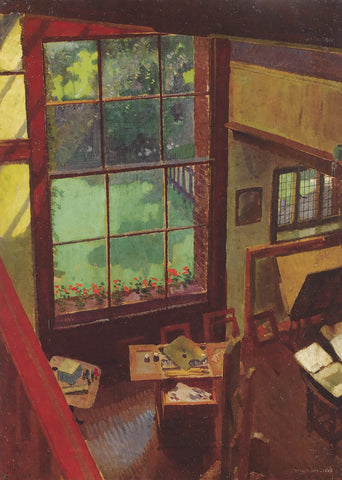2023 | Modernism at the Mall
Our 2023 feature exhibition tells the story of the Mall Studios, an artists’ enclave in Hampstead where Barbara Hepworth, Ben Nicholson, Henry Moore and Herbert Read changed the face of 20th Century British Art. NOTE: The exhibition is held at the Isokon Gallery. The Mall Studios itself is not open for visitors.
Tucked away in a quiet alley behind Parkhill Road, a discreet enclave of 19th century purpose-built artists’ studios, became, in its 1930s heyday, the home, workspace and social nexus of Britain’s avant-garde. It was the epicentre of abstract art in England, where the manifesto of British Modernism was written.
Designed by architect Thomas Batterbury, The Mall Studios were built in 1872, funded by the subscriptions of a group of artists, some of whom lived in adjoining houses in Parkhill Road. The studios’ size and form reflected the artists’ desire as “outsiders” to display work, beyond the remit of London’s commercial galleries, which was too large to be considered for the Royal Academy.
During the economic downturn of the late 1920s and early 1930s, the Hampstead's large villas were divided up and their rooms rented out cheaply to artists, and as the political climate darkened across Europe, artistic and intellectual exiles fleeing Nazi persecution, sought refuge in there. It was the perfect microclimate for the development of Modern British Art.

The Mall Studios were converted into combined living and working spaces. Their high ceilings made them ideal for sculptors. It was in the late 1920s that the enclave’s most celebrated Modernist residents began to arrive, turning Mall Studios into the epicentre of Britain’s avant-garde. In 1927, sculptors Barbara Hepworth and her first husband Jack Skeaping, moved in to Studio 2. After their divorce, Hepworth continued to live and work in the studios with her second husband, the painter Ben Nicholson. Their close friend and frequent visitor, sculptor Henry Moore, who lived in Parkhill Road, moved into their studio, when the couple decamped to St Ives. The painter Cecil Stephenson moved into number 6 in 1919 and lived there until 1965. His early work was figurative but it became abstract in the 1930s, most likely due to his Modernist neighbours.

This group were often joined in the Mall Studios by European émigrés, the Russian Constructivist Naum Gabo and Dutch painter, Piet Mondrian, who both lived nearby. Former Bauhaus Masters, Walter Gropius, Marcel Breuer and László Moholy-Nagy also lived and socialised in the Isokon Flats in Lawn Road, five minutes’ walk away. In 1938 Alexander Calder gave a performance of his wire circus in Stephenson’s studio where the audience sat on crates, drank beer from a barrel and watched the little figures and animals perform circus tricks. A key figure in this Modernist circle, was another Mall Studios resident, the eminent art critic Herbert Read, who famously described the community as ‘a nest of gentle artists’. In 1934, Read wrote Unit One, the book which formalised the manifesto of British Modernism, which accompanied Unit One’s seminal exhibition.
—
Curated by architect, artist and sculptor, Celia Scott – herself a Mall Studios resident - the Isokon Gallery’s lavishly illustrated exhibition outlines the origins of The Mall Studios and their celebrated residents over 150 years; from the buildings’ construction and first artists; their development as the epicentre of the Modern Movement in London; through to the present day. The display offers both a compelling historical record and a worthy celebration of a unique story in British art and culture.
